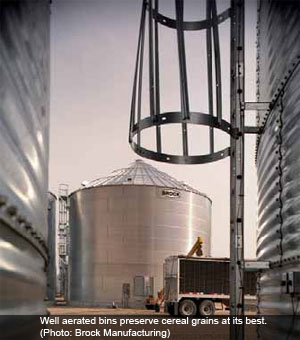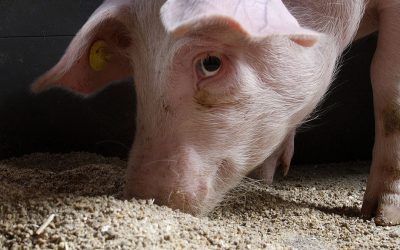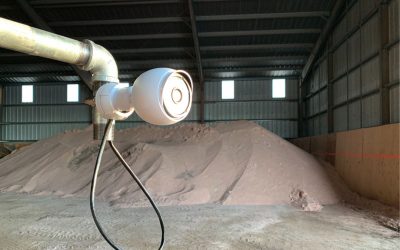Fighting fungi in grain storage preserves cereal quality

The main objective of proper grain storage is to maintain the quality and characteristics that the grain possessed immediately after harvesting and drying. The quality of grain cannot be improved during storage. Grain improperly harvested and dried will remain of low quality no matter how well it is stored.
When storing grains the main enemies to conquer are fungi (moulds). Respiration may, in certain cases, contribute to a loss of dry matter during grain storage. However, the losses due to respiration are minor compared to those caused by living organisms. Losses caused by fungi in cereal grains are related to:
- A decrease in germination,
- Discoloration of the seed,
- Heating and mustiness,
- Biochemical changes,
- Possible production of toxins, and
- Loss in dry matter.
All these changes may occur without the moulds becoming visible to the naked eye.
Storage moulds are prevalent in storage facilities when the grain moisture content is too low for field moulds (less than about 20%). The moisture and temperature requirements of these moulds determine the safe storage period. By controlling moisture content and temperature, mould growth is restricted and grain can be dried without significant spoilage. Grain temperature and moisture content determine the allowable storage time (AST) or how long grain can be kept before it spoils. Figure 1 gives an estimate of how much time there is to dry grain before it spoils, and how long grain quality can be maintained in storage. Mechanical damage to grain and the amount of foreign material also affects allowable storage time. Clean grain and whole seeds are more resistant to mould.
For long-term storage grain should be dried as soon as possible after it comes from the field. A delay in drying decreases the allowable storage time. However, the average moisture content throughout the grain bin does not determine how long cereal grains can be stored. Spoilage may occur at isolated locations in the bin where grain moisture is high. Grain stored in a bin at a relatively low average moisture content of 13%, but with the moisture content ranging between 10% and 16%, is not safe for long-term storage because of the excessive moisture content (16%) of part of the grain.
Grain temperature, moisture migration
Improper control of the temperature inside the bin causes moisture to move or migrate from one part of the grain mass to another, where the moisture can accumulate and cause grain spoilage problems.
Although moisture migration problems can occur at any time grain temperatures vary considerably, the most critical time occurs when warm grain is stored in cold winter temperatures. This is especially true for large bins. In the autumn, when the air temperature cools down, the grain along the bin wall cools more quickly than the rest of the grain. The difference in temperature starts air moving down the bin wall and toward the centre of the bin. As the air moves through the grain it becomes warmer and begins to pick up moisture from the grain. When the warm moist air hits the cool upper surface of the grain, condensation occurs. In the spring the problem is reversed. Warming action from the sun on the outside of the bin causes moisture currents to move up and into the bin. Condensation then occurs on the bottom of the bin.
| Heated air grain drying Whenever aeration or natural air drying fails to adequately condition grain for storage, a heated air dryer may be incorporated into the harvesting storage system. Compared to natural air drying, the heated air drying absorbs more moisture from the grain thus drying the grain faster. Over-drying of a cereal grain however, reduces the weight of grain that will be sold as less water is being sold. Also, it is more expensive in terms of energy costs. These costs must be balanced against how long the wheat has to be safely stored and under what storage conditions. Some factors should be considered for drying cereal grain: – Low temperatures should be used if the grain is to be stored for 6 months or more. – The damper the grain, the longer the drying process. Low temperatures should be used. – Lower temperatures should be used in dryers which do not mix or circulate the grain. Because excessive heat can damage cereal grain and reduce their ability to germinate, maximum safe air temperatures must not be exceeded. Solar drying |
Aerate for temperature control
Modern grain management uses aeration to control grain temperature and to reduce moisture variations. Aeration forces air through the grain either continuously or intermittently. Aeration is not a grain drying system and should not be used as one.
Grain drying or re-wetting is usually insignificant during grain aeration, because the cooling (or warming) front moves through the grain about 50 times faster than a drying or wetting front.
Grain can be tempered (cooled or warmed) by either negative or positive aeration systems. With either system, a tempering (cooling or warming) zone moves through the grain. The movement of the tempering zone completely through the grain is one cooling or warming cycle. Once a cycle had been started, operate the fan continuously until the zone moves completely through the grain. The time required to complete each cycle depends almost entirely on the aeration airflow rate. In a positive pressure system, the tempering zone starts at the bottom of the bin and moves up.
When moving air upwards, aeration progress can be easily determined by checking the grain temperature at the top centre. Also, with an upward airflow, the fan can be started immediately and air leaving the duct will keep the perforations clean.
In the negative pressure system, the tempering zone starts at the top of the bin and moves down.
The main advantage is to minimise roof condensation when aerating warm grain in cold weather. The uncertainty of knowing when aeration is complete is the main disadvantage, since the grain at the bottom is the hardest to check.
Aeration air flow rates
Airflow rates for aeration are normally 1-2 litres of air per second per cubic metre of grain (or 0.08-0.16 cubic feet of air per minute per bushel of grain).
The time for one cooling or warming cycle to completely pass through grain can be estimated by the following formula.
No. of hours to cool or warm the grain = 195/airflow rate (L/s-m3) or 15/airflow rate (cfm/bu), where L/s-m3= litres per second per cubic metre and cfm/bu = cubic feet per minute per bushel (1 cfm/bu = 13 L/s-m3). Recommended air flow rates for aeration are 1-2 L/s-m3(0.08 – 0.16 cfm/bu).
The bin floor should be 15% perforated (minimum). Grain put into the bin should be within 1% of dry. Screen the grain to reduce foreign material and fines as they increase resistance to air flow and reduce total airflow. Level the top of the grain to promote uniform air flow through the grain mass. Operate the fan long enough to complete a cycle (cooling or warming).
Fan operation
Aerating of the grain depends on the season and during which period it should be stored. In autumn the grain should be cooled as quickly as possible. Start aerating as soon as the grain is in the bin. Check the grain temperature and turn off the fan when it is less than 5°C (9°F) above the outside temperature. Check the grain periodically for condensation or heating. If the grain will be kept over winter, turn the fan on again when the outside temperature gets colder and aerate until the grain temperature is less than 5°C (9°F) above the outside temperature. Continue these cooling stages until the entire volume of grain is close to 0°C (32°F). After turning the fan off, cover the opening to keep the rodents out. When the outside temperature is close to that of the grain, run the fan for a day or two.
If the grain is being held over the summer, a series of warming stages beginning in spring is recommended. Continue until the grain temperature is about 10°C (50°F). By the beginning of summer the grain temperature should be 10°C (50°F).
Check the grain periodically and run the fan during cool, fair weather when the outside temperature is lower than the grain temperature. If there are any signs of heating or hot spots, no matter what the season or the weather, run the fan continuously until no heating can be detected.
Consider installing temperature sensing units in large grain storages. Temperature sensors accurately trace the progress of aeration cooling or warming cycles. They help identify hot spots within the grain mass.
Managing fines in storage
Broken grain and foreign material, or fines, can create two problems in stored grain, particularly when they accumulate in pockets. First, broken kernels are more susceptible to spoilage than unbroken ones. Secondly, airflow from aeration fans tends to go around pockets of fines so they cool more slowly. The pockets often develop into hot spots that result in spoiled grain.
Serious efforts should be made to reduce the fines produced by harvesting, drying and handling, rather than trying to resolve storage problems later. Three grain storage management techniques that reduce the problem from fines are as follows:
- Use a grain spreader to minimise the concentration of fines in storage.
- Clean the grain before binning to improve storability.
- Remove grain from the centre a few times during filling to remove accumulated fines.
Insect control
Insect infestations in storage can come from grain residues in combines, handling equipment, and from old grain left in storage. Correctly drying, aerating and managing stored grain will minimise the risk of insect infestation and damage. Insect activity goes with moisture accumulation and grain heating.
Look for insect activity on every storage visit. If an insect problem is noted, fumigate with a liquid, solid or gas grain fumigant in storage or as the grain is being turned. Fumigants are toxic and must be applied with proper safety precautions and equipment. Each fumigation job is different; hire a professional applicator.
Adapted from Alberta Agriculture and Rural Development (Kris Chawla) and the Canada Grain Council’s Complete Guide to Wheat Management











